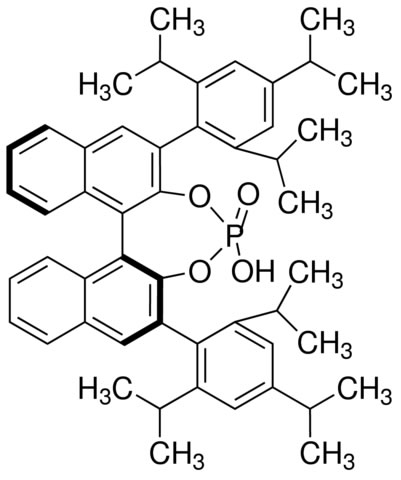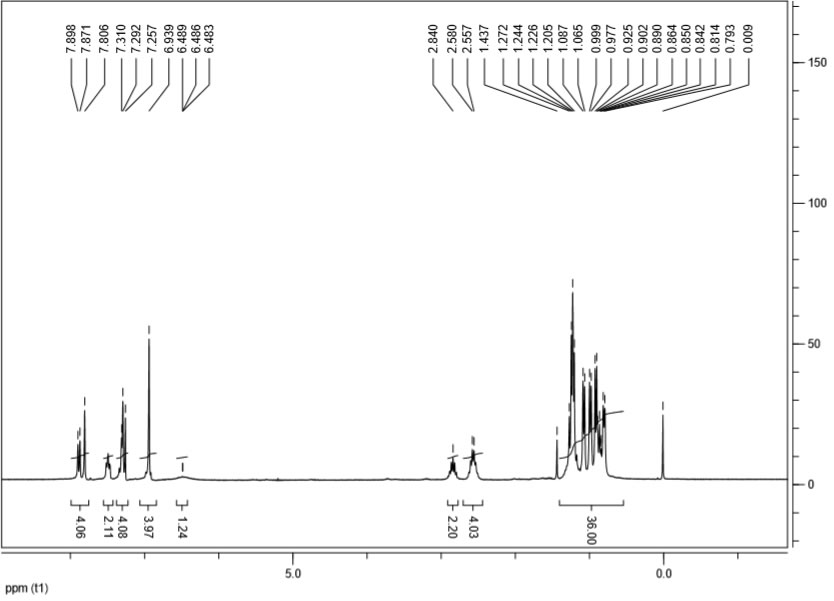(S)-3,3′-Bis(2,4,6-triisopropylphenyl)-1,1′-binaphthyl-2,2′-diyl hydrogenphosphate CAS#: 874948-63-7; ChemWhat Code: 1261232
Identification
| Product Name | (S)-3,3′-Bis(2,4,6-triisopropylphenyl)-1,1′-binaphthyl-2,2′-diyl hydrogenphosphate |
| IUPAC Name | 13-hydroxy-10,16-bis[2,4,6-tri(propan-2-yl)phenyl]-12,14-dioxa-13λ5-phosphapentacyclo[13.8.0.02,11.03,8.018,23]tricosa-1(15),2(11),3,5,7,9,16,18,20,22-decaene 13-oxide |
| Molecular Structure |  |
| CAS Registry Number | 874948-63-7 |
| MDL Number | MFCD10567009 |
| Synonyms | (11bS)-4-Hydroxy-2,6-bis[2,4,6-tris(1-methylethyl)phenyl]dinaphtho[2,1-d:1′,2′-f]-1,3,2-dioxaphosphepin 4-oxide, (S)-3,3′-Bis(2,4,6-triisopropylphenyl)-1,1′-bi-2-naphthol cyclic monophosphate, (S)-TRIP |
| Molecular Formula | C50H57O4P |
| Molecular Weight | 752.974 |
| InChI | InChI=1S/C50H57O4P/c1-27(2)35-23-39(29(5)6)45(40(24-35)30(7)8)43-21-33-17-13-15-19-37(33)47-48-38-20-16-14-18-34(38)22-44(50(48)54-55(51,52)53-49(43)47)46-41(31(9)10)25-36(28(3)4)26-42(46)32(11)12/h13-32H,1-12H3,(H,51,52) |
| InChI Key | AGQAQYPGJDBIQR-UHFFFAOYSA-N |
| Canonical SMILES | CC(C)C1=CC(=C(C(=C1)C(C)C)C2=CC3=CC=CC=C3C4=C2OP(=O)(OC5=C4C6=CC=CC=C6C=C5C7=C(C=C(C=C7C(C)C)C(C)C)C(C)C)O)C(C)C |
Physical Data
| Appearance | White to brown solid |
Spectra
| Description (NMR Spectroscopy) | Nucleus (NMR Spectroscopy) | Solvents (NMR Spectroscopy) | Temperature (NMR Spectroscopy), °C | Frequency (NMR Spectroscopy), MHz |
| Chemical shifts | 1H |
| (S)-3,3′-Bis(2,4,6-triisopropylphenyl)-1,1′-binaphthyl-2,2′-diyl hydrogenphosphate CAS#: 874948-63-7 HNMR |  |
Route of Synthesis

| Conditions | Yield |
| In toluene at 65°C; not isolated; |
Safety and Hazards
| Pictogram(s) |  |
| Signal | Warning |
| GHS Hazard Statements | H315: Causes skin irritation [Warning Skin corrosion/irritation] H319: Causes serious eye irritation [Warning Serious eye damage/eye irritation] H335: May cause respiratory irritation [Warning Specific target organ toxicity, single exposure; Respiratory tract irritation] For more detailed information, please visit ECHA C&L website |
| Precautionary Statement Codes | P261, P264, P271, P280, P302+P352, P304+P340, P305+P351+P338, P312, P321, P332+P313, P337+P313, P362, P403+P233, P405, and P501 (The corresponding statement to each P-code can be found at the GHS Classification page.) |
| Source: European Chemicals Agency (ECHA) License Note: Use of the information, documents and data from the ECHA website is subject to the terms and conditions of this Legal Notice, and subject to other binding limitations provided for under applicable law, the information, documents and data made available on the ECHA website may be reproduced, distributed and/or used, totally or in part, for non-commercial purposes provided that ECHA is acknowledged as the source: “Source: European Chemicals Agency, http://echa.europa.eu/”. Such acknowledgement must be included in each copy of the material. ECHA permits and encourages organisations and individuals to create links to the ECHA website under the following cumulative conditions: Links can only be made to webpages that provide a link to the Legal Notice page. License URL: https://echa.europa.eu/web/guest/legal-notice Record Name: (R)-3,3′-Bis(2,4,6-trisopropylphenyl)-1,1′-binapthyl-2,2′-diyl hydrogenphosphate URL: https://echa.europa.eu/information-on-chemicals/cl-inventory-database/-/discli/details/248511 Description: The information provided here is aggregated from the “Notified classification and labelling” from ECHA’s C&L Inventory. Read more: https://echa.europa.eu/information-on-chemicals/cl-inventory-database |
Other Data
| Transportation | Not dangerous goods |
| Under room temperature for shipment | |
| HS Code | 294200 |
| Storage | Under refrigerated for long time and filled with nitrogen. |
| Shelf Life | 1 year |
| Market Price | USD 88/g |
| Use Pattern |
| Pharmaceutical intermediate |
| Versatile organocatalyst. Uses include asymmetric reductive amination, enantioselective Diels-Alder reactions and asymmetric counteranion-directed catalysis (ACDC). Can be used in cooperation with chiral iridium complexes to catalyze greener asymmetric reductive amination using hydrogen gas. |
Buy Reagent | |
| No reagent supplier? | Send quick inquiry to ChemWhat |
| Want to be listed here as a reagent supplier? (Paid service) | Click here to contact ChemWhat |
Approved Manufacturers | |
| Caming Pharmaceutical Ltd | https://www.caming.com/ |
| Want to be listed as an approved manufacturer (Requires approvement)? | Please download and fill out this form and send back to approved-manufacturers@chemwhat.com |
Other Suppliers | |
| Watson International Limited | Visit Watson Official Website |
Contact Us for Other Help | |
| Contact us for other information or services | Click here to contact ChemWhat |

